Abstract
The fourth industrial revolution is accelerating industrial automation. In industrial networks, manufacturing processes require hard real-time communication where the latency is less than 1ms. Time-sensitive networking (TSN) technology over Ethernet already supports deterministic delivery for real-time communication. However, TSN technologies over wireless networks are currently in their initial development stage. Therefore, this study presents an overview of TSN research trends in wireless communications. This paper focuses on 5G networks and IEEE 802.11. We summarize standardization trends for TSN in 5G networks and introduce the TSN technologies for 802.11-based WLAN. Then, we introduce the integration scenario of 5GS with WLAN. This study provides insights into wireless communication technologies for wireless TSN.
1. Introduction
Industrial automation is a representative system attracting attention in the fourth industrial revolution. In the industrial automation system, data and controls are exchanged between manufacturing equipment within a fixed period of time [1]. The soft real-time manufacturing system that allows some deadline misses requires latency of 10–50 ms. In a hard real-time manufacturing system where operations must be completed within a deadline, the latency is less than 1 ms because of low cycle time [2]. In addition to low latency, a significant amount of data must be transmitted without data loss with low jitter for hard real-time networking. Therefore, to support deterministic transmission, researchers focused on time-sensitive networking (TSN).
TSN, developed by the IEEE 802.1 Task Group, is a standard technology based on Ethernet (802.3) and can achieve low transmission delay, low jitter, and reliable packet transmission [3]. The Ethernet-based TSN technology can support services from soft real-time networking to hard real-time networking, and it requires wiring, network equipment, etc. to connect manufacturing equipment. However, in industrial networks, wired-based networks do not provide scalability and flexibility because the wiring cost increases as manufacturing equipment is added or relocated frequently. To construct scalable networks and offer mobility of manufacturing equipment, the wireless TSN, where the TSN technology is required to extend from wired networks to wireless networks (e.g., 5G and 802.11be), has been proposed [4]. However, because communication environments and mechanisms differ between wired networks and wireless networks, the Ethernet-based TSN technology is not compatible with wireless technologies, and several researchers have addressed wireless TSN [2,5,6,7,8,9,10].
In wireless networks, the soft real-time manufacturing process is supported by LTE networks and 802.11ax [2]. However, because the hard real-time manufacturing process requires sophisticated deterministic transmission, next generation of wireless communication technologies such as 5G and 802.11be are required. For the 5G System (5GS) to support TSN, a new function is required. To manage the periodically transmitted TSN traffic, time synchronization must be supported. Currently, because a 5GS does not provide time synchronization between the user equipment (UE), radio access network (RAN), and user plane function (UPF), a new time synchronization mechanism is required. In addition, a new buffering and scheduling mechanism is required for processing TSN traffic because guaranteeing a deterministic delay as well as a low delay is necessary.
The WLAN can be used for TSN besides 5GS. The TSN over WLAN can be implemented without modification of TSN reference architecture because WLAN technology is one of the IEEE 802 family of MAC layer [2]. In wireless TSN over WLAN, time synchronization is required. However, while the Ethernet network interface card (NIC) supports precision time protocol (PTP) for accurate time synchronization [11,12], less accurate time synchronization is achievable because the wireless NIC does not provide a PTP hardware clock (PHC). For time synchronization, timing measurement (TM) and fine timing measurement (FTM) have already been proposed in wireless TSN [5]. Both Ethernet and 802.11-based WLAN use contention-based packet transmission and determine whether packets are transmitted through channel-state monitoring. However, because WLAN cannot detect collisions, it uses a random backoff counter to avoid collisions. The random backoff mechanism increases the transmission delay and causes a high jitter. Thus, maintaining the delay within a particular range is challenging.
In this paper, we have summarized TSN technologies in a wireless communication environment. As shown in Figure 1, TSN uses three technologies as underlying technology: Ethernet, WLAN, and 5GS. For wireless TSN, we describe 5G technology and 802.11-based WLAN except for wired-based Ethernet. 3GPP and IEEE are standardizing and researching technologies for wireless TSN in 5GS and WLAN respectively. However, we expect that 5GS is used in conjunction with WLAN to implement wireless TSN. Therefore, we proposed an integration network architecture that can be used together with 5G new radio (NR) and WLAN, and then we derive necessary technologies for providing TSN service based on the proposed architecture. The paper is organized as follows. First, we introduce Ethernet-based TSN technologies and use cases in Section 2. Section 3 and Section 4 introduce the research results of wireless TSN over 5G networks and 802.11-based WLAN. Then, we explain the integration model of 5GS and WLAN for wireless TSN in Section 5. Finally, The conclusions are presented in Section 6.
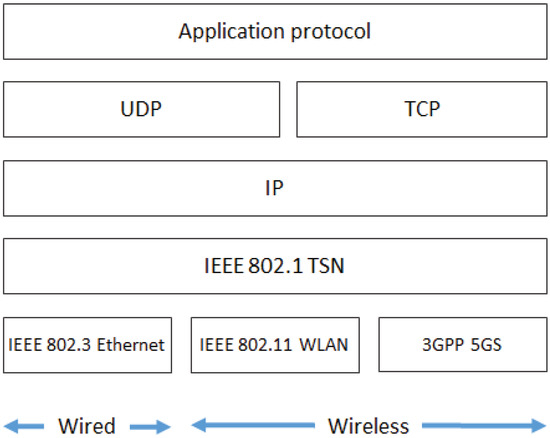
Figure 1.
Network architecture for TSN.
2. Background
TSN is an extension of the audio video bridging (AVB) technology, which is based on Ethernet. The TSN technology aims to provide reliable packet delivery with deterministic latency. To achieve this, the IEEE 802.1 TSN Task Group developed a TSN standard encompassing time synchronization, bounded low latency, reliability, and resource management technologies [3].
TSN technologies for bounded low latency, reliability, and resource management depend on the time synchronization between TSN nodes. IEEE 802.1AS defined the gPTP to achieve a time synchronization in the millisecond range for all nodes in an Ethernet network [11,12]. The gPTP performs time synchronization between network devices by delivering synchronization event messages (sync, delay, etc.) between the clock master and the clock slave. Because the Ethernet-based NIC provides the PHC, the clock time of the slave device is synchronized with that of the master device.
Bounded low latency is a technology for transmitting packets within a limited transmission delay. TSN guarantees bounded low latency in a bridged network by adding delay-determined forwarding and queuing functions to the existing IEEE 802.1 bridge. Accordingly, each bridge provides a determined end-to-end delivery latency by processing the TSN stream in a cycle corresponding to the synchronized time. To achieve bounded low latency, time-aware scheduling and frame pre-emption have been proposed. First, time-aware scheduling divides Ethernet traffic into eight priorities and ensures that the allocated transmission time for each priority is within a communication cycle. Because high-priority traffic avoids congestion and channel contention with low-priority traffic, it achieves low latency [13]. Second, when more urgent or crucial packet transmission is required, frame pre-emption stops the transmission of the outgoing low-priority packet and transmits a packet with high priority. Then, the stopped packet transmission is resumed [14,15].
The TSN standard improves the reliability of packet transmission by redundantly transmitting packets through multiple paths [16]. This redundant transmission not only improves transmission reliability but also prevents retransmission delay due to packet loss. To minimize the increase in network traffic due to redundant transmission, when a packet arrives at the destination, the other redundant packets are removed from other transmission paths.
Resource management for TSN uses three models: fully distributed model, centralized network/distributed user mode, and fully centralized model. For stream reservation in the fully distributed model, the talker sends network configuration information of the stream (i.e., service traffic) to the listener using the stream reservation protocol (SRP) [17]. Then the listener returns the stream ID. The centralized network/distributed user model allows talkers and listeners to reserve resources using SRP, and the user/network configuration information is delivered to centralized network configuration (CNC) for resources reservation. As shown in Figure 2, the fully centralized model reserves and manages resources through centralized user configuration (CUC) and CNC. The centralized network/distributed user model or fully centralized model using CNC/CUC manages resources using the YANG model [18,19].

Figure 2.
Centralized network configuration (CNC) model.
As wireless communication technologies such as 5G and 802.11ax emerges, TSN has been extended to wireless networks [4]. Figure 2 describes the example of 802.11-based wireless TSN for industrial network [20]. Since wireless TSN provides some benefits compared to wired TSN, several groups have addressed industrial use cases such as closed loop system and mobile robot system [21,22,23]. The wireless TSN enables deployment flexibility, mobility, low maintenance cost for closed loop system and mobile robot system.
3. 3GPP 5G Technology for TSN
5GS is a representative example of wireless TSN, and standardization work has continuously been made to provide deterministic communication for transmitting TSN traffic by integrating with TSN network. In 3GPP, a 5GS was established to support large-capacity broadband services in Release 15; in Release 16, standardization work satisfying service requirements, such as massive IoT, reliability, and low latency, was completed in 2020. In particular, in Release 16, the three technologies listed in Table 1 were presented to support industrial IoT, and standard specifications were developed [24]. Among them, the interworking technology with IEEE 802.1 TSN, which requires time-sensitive communication, continued to develop standards in Release 17 [25]. This section describes the standard technology for 5GS interworking with TSN based on 3GPP Release 16 and introduces issues in TSN interworking technology developed in Release 17.

Table 1.
5GS support for industrial IoT (3GPP Release 16) [26].
3.1. Support for Integration with TSN
Various interworking architecture were considered for 3GPP 5GS interworking with TSN [27]. Currently, 5GS operates as a single TSN bridge and is connected to the TSN bridge of multiple TSN domains to provide service. As shown in Figure 3, a new function was added to the control plane and user plane in 5GS to interwork with the TSN bridge. 3GPP 5GS defines the translator functionality for interworking with TSN [28], including device-side TSN device (DS-TT) and network-side TSN translator (NW-TT) for the user plane and TSN application function (AF) for the control plane. DS-TT and NW-TT perform the role of a bridge port, and TSN AF interlocks with the CNC of the TSN system to perform control for the TSN service. Within 5GS, the TSN AF can control DS-TT/NW-TT through 5GS signaling.
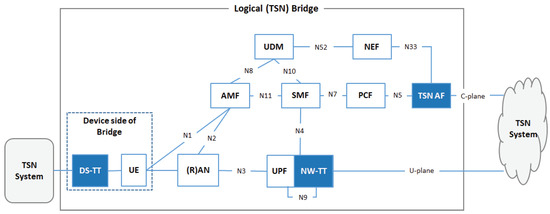
Figure 3.
5GS acting as a TSN bridge [28].
With 5GS acting as a TSN bridge, one logical bridge per UPF can be formed. Here, the 5GS bridge comprises UPF ports, UE-UPF tunnels, and DS-TT ports. For TSN traffic transmission within 5GS, the UPF manages traffic transmission between port pairs by mapping one PDU session to one DS-TT port. For 5GS to operate as a TSN bridge, bridge information should be configured first in 5GS, and then, the 5GS bridge information should be reported to the CNC of the TSN network. 5GS receives the bridge configuration information from the CNC and maps it to 5GS Quality of Service (QoS) information (e.g., 5G QoS Identification (5QI) and time-sensitive communication assistance information (TSCAI)). The TSN AF communicates with the CNC in 5GS, transmitting port and bridge information to DS-TT/NW-TT.
3.2. Periodic Deterministic QoS
Scheduled traffic and per-stream filtering and policing (PSFP) defined in IEEE 802.1Q are supported by 5GS. For this purpose, the policy control function (PCF) maps the TSN QoS received from TSN AF to the 5GS QoS flow. Moreover, 5GS supports periodic deterministic QoS by defining TSCAI with TSN traffic pattern information transmitted between next generation NodeB (gNB) and UE. Table 2 lists the TSCAI parameters that exist per QoS flow. The session management function (SMF) creates TSCAI with QoS flow information received from PCF and delivers it to gNB along with the QoS profile information. In this case, the TSC QoS flow uses a delay-critical guaranteed bit rate (GBR) resource type. In addition, for de-jittering the traffic flows transmitted in 5GS, DS-TT/NW-TT supports a hold and forward buffering mechanism.

Table 2.
TSCAI [28].
To handle TSN-scheduled traffic, 5GS must provide a 5GS bridge delay as defined in IEEE 802.1Qcc. Therefore, in 3GPP, the 5GS bridge delay is defined as the sum of UE-DS-TT residence time and per traffic class minimum and maximum delays between the UE and the UPF/NW-TT. The UE-DS-TT residence time corresponds to the time spent to transfer a packet between the UE and the DS-TT port. The per traffic class delay is pre-configured by TSN AF.
3.3. TSN Time Synchronization
TSN time synchronization is supported by 3GPP 5GS, which is an IEEE 802.1AS time-aware system. Moreover, 5GS is a 5G grandmaster (GM), where UE, gNB, UPF, NW-TT, and DS-TTs are synchronized, and only TSN translators at the 5GS edge support IEEE 802.1AS. Therefore, the following two synchronization systems exist [28]:
- –
- 5GS synchronization is used for 5G RAN synchronization [29].
- –
- TSN-domain synchronization follows IEEE 802.1AS.
The 5GS clock is first synchronized by the gNB with the 5G GM. The gNB delivers the time information to the UE by 5GS signaling, and the DS-TT is synchronized with the 5GS clock by the UE [29]. UPF/NW-TT receives a 5GS clock from the gNB through the underlying PTP compatible transport network. As for the TSN clock [30], the NW-TT receives a gPTP message from the TSN network where the TSN GM exists, updates the link delay and cumulative rateRatio, and adds the ingress time stamping (TSi) value [24]. The NW-TT delivers the received gPTP message to the UEs belonging to the TSN domain through all the PDU sessions connected to the UPF. Upon receiving the gPTP message, the UE transmits it to the DS-TT, and the DS-TT generates egress time stamping (TSe) and calculates the difference between TSe and TSi values as the residence time within 5GS for the gPTP message. The DS-TT deletes TSi from the gPTP message and adds the residence time to transmit it. In particular, 3GPP Release 16 5GS provides time synchronization supporting multiple TSN working domains using “domain number” in the gPTP messages.
3.4. TSN Issues in Release 17
In Release 17, 5GS intends to support uplink synchronization for interworking with TSN [25]. In Release 16, only the architecture where the TSN GM is connected to the network side was supported. However, Release 17 intends to develop a standard technology in which 5GS provides time synchronization in the architecture where multiple TSN GMs are connected to the UE side (Figure 4). In addition, Release 17 has proposed various methods to support UE-to-UE communication that inevitably occurs due to uplink synchronization [31]. As a result, the 5GS uses a local switch, where traffic is forwarded locally by a single UPF, for UE-to-UE communication. The 3GPP mobile communication system generally supports uplink/downlink traffic communication between UE networks. Nevertheless, for uplink synchronization, when a UE is connected to the TSN, the GM receiving a gPTP message must transmit the message to a network and other UEs belonging to the same TSN domain. Accordingly, UE-to-UE communication occurs when the uplink traffic and downlink traffic occur together.
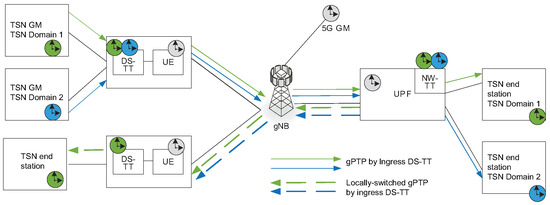
Figure 4.
Uplink synchronization [25].
4. IEEE 802.11 Technology for TSN
The wireless TSN uses not only 5GS but also WLAN technology as lower layer. In 2021, IEEE 802.11 working group released draft 8.0 document for 802.11ax which is recent wireless MAC protocol to support high efficiency under dense networks [32,33]. In 802.11ax, orthogonal frequency division multiple access (OFDMA) and triggered transmission was proposed to reduce latency and to increase throughput. Table 3 lists the relationships between the TSN features (such as latency, reliability, resource management) and the 802.11ax technologies. New capabilities in 802.11ax enables wireless TSN because they reduces latency and channel contention. This section introduces 802.11-based technologies highly related to TSN. Among studies from 802.11b to 802.11be, we introduce technologies for time synchronization, low latency, transmission reliability, and traffic scheduling.

Table 3.
Relationship between TSN features and 802.11ax.
4.1. TSN Time Synchronization
This section introduces studies for time synchronization for TSN deployment in 802.11-based WLAN. TM or FTM has been used for time synchronization [5]. Figure 5 shows the FTM operation. The FTM request from the slave station initiates the FTM mechanism. The master station sends the FTM message within 10 ms of receiving the FTM request. The master station transmits the FTM(n) message to the slave station and measures the transmission time, . The records of and are piggybacked in the FTM(n) message to inform the slave station. When n is 1, and information is excluded. When the slave station receives the FTM(n) message, it measures . The slave station measures the transmission time while transmitting the ACK message. Finally, , which is the time when the master station receives the ACK message, is recorded. , which is the transmission delay time from the master station to the slave station, is calculated as . Moreover, the lowest among n delay times is used in the time synchronization calculation [30].
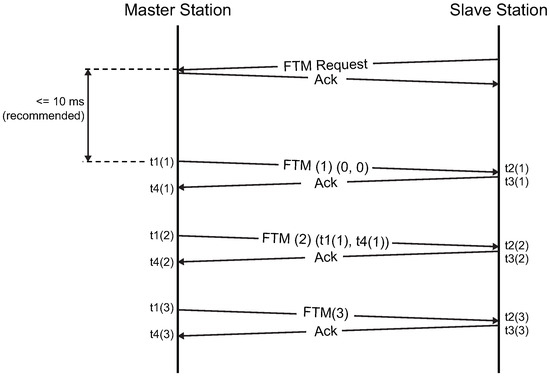
Figure 5.
Fine timing measurement (FTM) mechanism [30].
4.2. Low-Latency Technology
The authors of [34,35] proposed a packet size reduction technique and a new queuing technique to achieve the bounded low latency. In [36], multiple physical layer interfaces are used in a wireless NIC to reduce the packet transmission time by transmitting multiple packets simultaneously. 802.11e proposed four access categories based on service characteristics, and the priorities for each category are distinguished [37]. For the service with the highest priority, frequent channel access is provided. In addition, multiple transmission opportunities are provided through one channel access, therefore reducing the channel contention overhead and delay time.
OFDMA proposed in 802.11ax divides a single channel into several sub-channels called resource units (RUs) to support simultaneous transmission from multiple stations [2,6,7]. Figure 6 shows an example of the OFDMA transmission. In the figure, the AP transmits a trigger frame (TF) including association identifier (AID), which represents stations assigned to each RU. After receiving the TF, the stations transmit packets in the same RU as their AID. An RU with an AID of 0 is used for random access. A station with an AID of 0 transmits packets when their OFDMA backoff (OBO) counter reaches 0. Because OFDMA enables simultaneous transmission from multiple stations, the queuing delay decreases, and therefore the transmission delay decreases.

Figure 6.
Example of OFDMA transmission.
4.3. Transmission Reliability
Transmission power control and redundant transmission techniques are used to ensure reliability within the TSN. Increment of the transmission power improves the transmission reliability because the resistance to bit errors increases. However, transmission power increment increases the interference range. Therefore, the transmission power is adjusted to minimize the interference while increasing the transmission reliability in an environment where multiple access points (APs) are installed [38,39]. As mentioned above, a wireless NIC has multiple physical layer interfaces, such as those of 802.11ac or 802.11ad [36]. By activating multiple interfaces simultaneously, a packet is redundantly transmitted over multiple paths to ensure transmission reliability to eliminate the retransmission time due to packet loss.
In 802.11ax, a spatial reuse (SR) was proposed to prevent communication interference between adjacent APs [7]. As shown in Figure 7, If AP1 and AP2 has equal clear channel assessment carrier sense (CCA/CS) threshold, both APs cannot transmit simultaneously because of carrier sensing. In SR, AP2 increases overlapping basic service set (OBSS) preamble detection (PD) threshold to ignore weak interference from the neighboring AP. Because increasing OBSS/PD threshold reduces the transmission power, the transmission range of AP2 decreases and interference from AP2 to AP1 also decreases. Therefore, transmission reliability is improved.
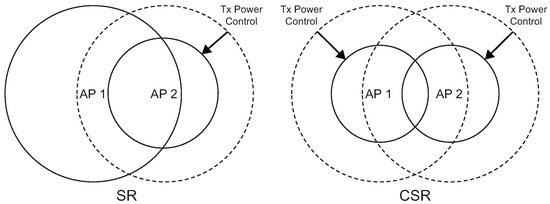
Figure 7.
SR and CSR.
4.4. Traffic Scheduling
Traffic scheduling studies of 802.11-based TSN are introduced [8,9]. In [8], SHARP used the time-division multiple access (TDMA) to support traffic scheduling between TSN traffic and non-TSN traffic. TDMA-based traffic scheduling decreases latency and improves reliability for TSN in a wired/wireless network environment. To implement TDMA in 802.11-based WLAN, the transmission period of TSN traffic and that of non-TSN traffic of 802.11 station are separated. To ensure communication only for the TSN node, the AP transmits a clear to send (CTS) signal without a request to send (RTS) signal to prevent channel access of 802.11 stations. When the wireless channel is idle, the TSN nodes preferentially transmits packets after short interframe space (SIFS) without random backoff. In addition, when an 802.11 station sends an RTS, a CTS is transmitted only if transmission is completed within the allotted time. In [9], the delay time for transmission from an AP to the corresponding node can be minimized by adding a new TSN access category that does not perform backoff for enhanced distributed channel access (EDCA) in the WLAN downlink. Therefore, TSN packets are transmitted preferentially.
802.11ax proposed the target wake time (TWT) that is a new power saving mechanism [2,10]. In wireless TSN, TWT is used for packet scheduling and the AP schedules packet transmission sequence of stations. As shown in Figure 8, the stations transmit a TWT request to the AP to participate in TWT, and the AP transmits a TWT response to the station. The TWT response includes the transmission time of the first target beacon (TBTT). Stations receiving the target beacon can communicate with the AP during the TWT service period (SP). As shown in Figure 8, if TWT and OFDMA are simultaneously used, because the channel contention is reduced during TWT SP, the reliability is improved and transmission delay decreases.
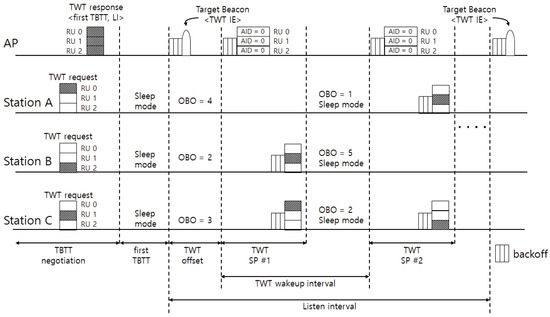
Figure 8.
TWT with OFDMA operation.
5. Integration WLAN with 5G TSN
In Section 3 and Section 4, we have looked at the technologies that 5GS and WLAN are researching to provide TSN service as wireless communication systems, respectively. Based on these technologies, it is possible for either the 5GS or WLAN to deploy an independent TSN network. However, the deployment architecture of the wireless communication system for TSN service may be different according to various types of service requirements in industrial automation environment. If necessary, it will also be possible to deploy a TSN network in which 5GS and WLAN are configured together. Currently, 5GS also has a network architecture that can accommodate different access networks (e.g., 5G NR and WiFi access) at the same time to provide various types of services. In this section, we introduce two possible architectures of wireless TSN when 5GS and WLAN are integrated together. The first case is when WLAN is used as an interface to connect to the TSN node, and the second case is when WLAN is used with 5G RAN within 5GS. Then, we discuss technical challenges for wireless TSN in the proposed architectures.
5.1. WLAN Access between UE and TSN Node
Most industrial IoT devices are easily connected by wired line or WLAN for TSN service, and Figure 9 shows an example where TSN nodes are each connected to an AP through a Wi-Fi interface. The existing WLAN technology does not guarantee deterministic communication because of unstable communication environment and random backoff-based channel access. If WLAN access is used as intermediate node in wireless TSN, hard real-time service cannot satisfy the requirements. To support real-time service, TSN is configured based on 5GS, and the UE and the TSN node are connected through WLAN. As shown in Figure 9, the 5GS works as a logical bridge by connecting the TSN backbone. NW-TT within 5GS connects the TSN backbone and DS-TT connects TSN nodes, and the traffic between NW-TT and DS-TT is transmitted according to the deterministic QoS of 5GS. WLAN provides connectivity between DS-TT and TSN nodes so that traffic forwarded by DS-TT can be forwarded to and from TSN nodes and vice versa.
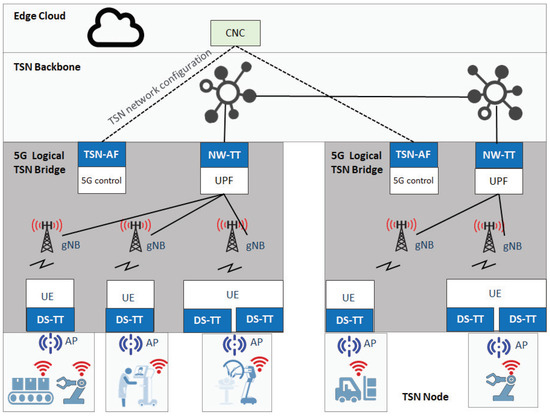
Figure 9.
WLAN access for TSN node.
5.2. WLAN Access within the 5G System
The 5GS simultaneously supports different types of access networks: not only 5G NR via gNB but also WiFi via non-3GPP interworking function (N3IWF). Therefore, WLAN can be used as well as 5G NR in 5GS as an access network. Figure 10 shows the integration model that simultaneously supports both 5G NR and WiFi access when the UE is equipped with 5G NR and WiFi interfaces. In this model, WLAN should support deterministic communication to provide deterministic QoS within the 5GS for the TSN service. However, WLAN does not guarantee deterministic transmission, so this integration model may be selectively used depending on service requirements.
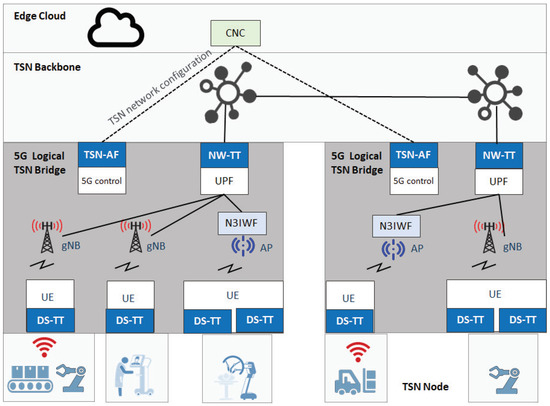
Figure 10.
WiFi access within the 5GS.
5.3. Technical Challenges in Wireless Communications for TSN
In this section, we discuss technical challenges in wireless communication for the TSN service. As discussed in Section 5.2, WiFi as well as 5G NR should guarantee deterministic transmission when 5GS uses 5G NR and WiFi accesses for TSN service. Figure 11 shows technologies for guaranteeing deterministic QoS between the UPF/NW-TT and UE/DS-TT based on the proposed architecture in Figure 9. To support deterministic transmission within the 5GS, DS-TT and NW-TT provide hold and forward buffering for de-jittering. 5G core network (CN) supports delay-critical guaranteed bit rate (GBR) and redundant transmission between the UPF and the gNB, and 5G RAN uses periodic transmission with TSCAI as well as delay-critical GBR and redundant transmission between gNB and UE. Eventually, the 5GS via 5G NR guarantees deterministic QoS delivery. However, WLAN currently does not guarantee the deterministic transmission although it uses enhanced technologies such as OFDMA, TWT, and SR.
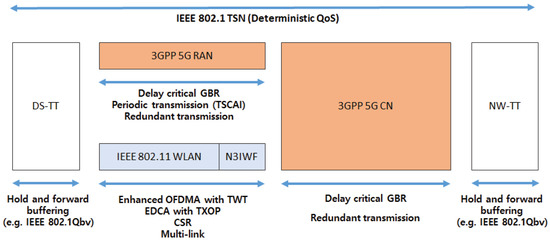
Figure 11.
Technologies for deterministic QoS in 5GS.
Due to the characteristics of WLAN, unstable communication environment and collision avoidance mechanism, WLAN cannot provide deterministic QoS service. This is because the unstable communication environment causes unexpected packet loss and unnecessary retransmission, and the collision avoidance mechanism causes unnecessary waiting time and increased latency. Therefore, 802.11ax has proposed OFDMA, SR, and TWT to reduce latency, improve reliability, and support power saving mode scheduling, respectively. Since OFDMA allocates a RU to each station, some RUs are not used when the number of active stations is less than the number of available RUs, so the delay is not significantly reduced. SR intends to improve reliability by reducing interference between adjacent APs. However, only one of the adjacent APs reduces transmission power when interference occurs between them, so there is a limit to improve reliability. In TWT, the AP does not provide QoS scheduling based on traffic priority although it schedules traffic transmission between the AP and the node.
After 802.11ax, 802.11be has been proposed as next MAC protocol of WLAN for further improvement [40,41]. For wireless TSN, several 802.11be technologies has been addressed to achieve deterministic QoS [40]. The 802.11be improved OFDMA performance by allocating multiple RUs for each station and reduced the latency by allocating RUs for direct links between the stations. For that, the description scheme for multiple RUs and allocation scheme of RU for direct transmission should be addressed. The 802.11be improves transmission reliability by performing multi-AP cooperation-based coordinated spatial reuse (CSR) [42]. As shown in Figure 7, in CSR, both APs adjust the transmission power to reduce mutual interference. The 802.11be proposed EDCA improvement and Multi-link operation to support TSN. New access categories (ACs) were added to the existing four ACs proposed, and transmit opportunities (TXOPs) are allocated to the corresponding ACs. EDCA reduces the latency and contention, and improves the transmission reliability. In a Multi-link operation, as shown in Figure 12, one MAC address is assigned to a wireless NIC; however, multiple physical interfaces are simultaneously activated, and data are transmitted through all physical interfaces. The joint mode in which packets are transmitted in multiple physical interfaces reduces the delay time, and the duplicate mode in which packets are redundantly transmitted to multiple physical interfaces improves transmission reliability. We expect that 802.11be will provide periodic deterministic communication using newly developed technologies such as enhanced OFDMA, CSR, EDCA with TXOP, and Multi-link.
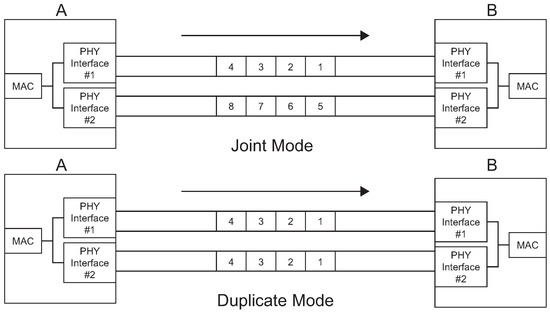
Figure 12.
Multi-link operation.
6. Conclusions
This study introduced research trends in TSN related to wireless networks such as 5G and 802.11 WLAN. TSN-related standardization trends in 5G networks were discussed and studies in 802.11-based WLAN including 802.11ax and 802.11be were introduced. In the future, studies focusing on applying TSN to wireless LAN or mobile communication environments will continue to be conducted owing to the advantages of TSN in wireless environments. In summary, this paper provided insights into the trends in TSN and related technologies employed for reliable and low-latency wireless communication. This survey could lay the foundation for establishing TSN in wireless communication environments.
Author Contributions
Conceptualization, Y.K. and D.A.; methodology, Y.K., S.L., S.G., T.K. and D.A.; formal analysis, Y.K. and D.A.; resources, T.K. and D.A.; writing—original draft preparation, Y.K. and D.A.; writing—review and editing, Y.K. and D.A.; visualization, S.L. and T.K. and D.A.; supervision, D.A.; project administration, Y.K. and D.A.; funding acquisition, Y.K. All authors have read and agreed to the published version of the manuscript.
Funding
This work was supported by the Institute of Information & Communications Technology Planning & Evaluation (IITP) grant funded by the Korea government (MSIT) (No. 2020-0-00974-002, Development of ultra-reliable and low-latency 5G+ core network and TSN switch technologies).
Institutional Review Board Statement
Not applicable.
Informed Consent Statement
Not applicable.
Data Availability Statement
Not applicable.
Conflicts of Interest
The authors declare no conflict of interest.
Abbreviations
The following abbreviations are used in this manuscript:
| TSN | Time-Sensitive Networking |
| Industrial IoT | Industrial Internet of Things |
| AR | Augmented Reality |
| VR | Virtual Reality |
| WLAN | Wireless LAN |
| NIC | Network Interface Card |
| PTP | Precision Time Protocol |
| PHC | PTP Hardware Clock |
| 5GS | 5G System |
| UE | User Equipment |
| RAN | Radio Access Network |
| UPF | User Plane Function |
| AVB | Audio Video Bridging |
| CNC | Centralized Network Configuration |
| CUC | Centralized User Configuration |
| FTM | Fine Timing Measurement |
| TM | Timing Measurement |
| AP | Access Point |
| EDCA | Enhanced Distributed Channel Access |
| TDMA | Time-Division Multiple Access |
| CTS | Clear To Send |
| RTS | Request To Send |
| SIFS | Short Interframe Space |
| OFDMA | Orthogonal Frequency Division Multiple Access |
| RU | Resource Unit |
| TF | Trigger Frame |
| AID | Association Identifier |
| OBO | OFDMA Backoff |
| TWT | Target Wake Time |
| SP | Service Period |
| SR | Spatial Reuse |
| OBSS | Overlapping Basic Service Set |
| PD | Preamble Detection |
| CSR | Coordinated Spatial Reuse |
| AC | Access Category |
| TXOP | Transmit Opportunity |
| AF | Application Function |
| QoS | Quality of Service |
| TSCAI | Time-Sensitive Communication assistance Information |
| PSFP | Per-Stream Filtering and Policing |
| PCF | Policy Control Function |
| gNB | generation NodeB |
| SMF | Session Management Function |
| CCA/Cs | Clear Channel Assessment Carrier Sense |
References
- Romanov, A.M.; Gringoli, F.; Sikora, A. A Precise Synchronization Method for Future Wireless TSN Networks. IEEE Trans. Ind. Inform. 2020, 17, 3682–3692. [Google Scholar] [CrossRef]
- Cavalcanti, D.; Perez-Ramirez, J.; Rashid, M.M.; Fang, J.; Galeev, M.; Stanton, K.B. Extending accurate time distribution and timeliness capabilities over the air to enable future wireless industrial automation systems. Proc. IEEE 2019, 107, 1132–1152. [Google Scholar] [CrossRef]
- Time Sensitive Networking Working Group, IEEE 802.1. Available online: https://1.ieee802.org/tsn (accessed on 3 June 2021).
- Cavalcanti, D.; Bush, S.; Illouz, M.; Kronauer, G.; Regev, A.; Venkatesan, G. Wireless TSN-Definitions Use Cases & Standards Roadmap; Avnu Alliance: Beaverton, OR, USA, 2020; pp. 1–16. [Google Scholar]
- IEEE. 802.11-2016-IEEE Standard for Information Technology—Telecommunications and Information Exchange between Systems Local and Metropolitan Area Networks-Specific Requirements—Part 11: Wireless LAN Medium Access Control (MAC) and Physical Layer (PHY) Specifications; IEEE: Piscataway, NJ, USA, 2016. [Google Scholar]
- Naik, G.; Bhattarai, S.; Park, J.M. Performance analysis of uplink multi-user OFDMA in IEEE 802.11 ax. In Proceedings of the 2018 IEEE International Conference on Communications (ICC), Kansas City, MO, USA, 20–24 May 2018; pp. 1–6. [Google Scholar]
- Deng, D.J.; Lin, Y.P.; Yang, X.; Zhu, J.; Li, Y.B.; Luo, J.; Chen, K.C. IEEE 802.11ax: Highly efficient WLANs for intelligent information infrastructure. IEEE Commun. Mag. 2017, 55, 52–59. [Google Scholar] [CrossRef]
- Seijo, O.; Fernández, Z.; Val, I.; López-Fernández, J.A. SHARP: Towards the integration of time-sensitive communications in legacy LAN/WLAN. In Proceedings of the 2018 IEEE Globecom Workshops (GC Wkshps), Abu Dhabi, United Arab Emirates, 9–13 December 2018; pp. 1–7. [Google Scholar]
- Genc, E.; Del Carpio, L.F. Wi-Fi QoS enhancements for downlink operations in industrial automation using TSN. In Proceedings of the 2019 15th IEEE International Workshop on Factory Communication Systems (WFCS), Sundsvall, Sweden, 27–29 May 2019; pp. 1–6. [Google Scholar]
- Chen, Q.; Weng, Z.; Chen, G. A target wake time scheduling scheme for uplink multiuser transmission in IEEE 802.11 ax-based next generation WLANs. IEEE Access 2019, 7, 158207–158222. [Google Scholar] [CrossRef]
- IEEE 802.1AS–Timing and Synchronization. Available online: https://www.ieee802.org/1/pages/802.1as.html (accessed on 3 June 2021).
- Cochran, R.; Marinescu, C.; Riesch, C. Synchronizing the Linux system time to a PTP hardware clock. In Proceedings of the 2011 IEEE International Symposium on Precision Clock Synchronization for Measurement, Control and Communication, Munich, Germany, 12–16 September 2011; pp. 87–92. [Google Scholar]
- IEEE 802.1Qbv-Enhancements for Scheduled Traffic. Available online: https://www.ieee802.org/1/pages/802.1bv.html (accessed on 12 May 2021).
- IEEE 802.1Qbu–Frame Preemption. Available online: https://www.ieee802.org/1/pages/802.1bu.html (accessed on 12 May 2021).
- IEEE 802.3br. Available online: https://standards.ieee.org/standard/802_3br-2016.html (accessed on 12 May 2021).
- IEEE 802.1CB–Frame Replication and Elimination for Reliability. Available online: https://1.ieee802.org/tsn/802-1cb (accessed on 12 May 2021).
- IEEE 802.1Qcc-Stream Reservation Protocol (SRP) Enhancements and Performance Improvements. Available online: https://standards.ieee.org/standard/802_1Qcc-2018.html (accessed on 12 May 2021).
- IEEE 802.1Qcp-2018-IEEE Standard for Local and Metropolitan Area Networks—Bridges and Bridged Networks—Amendment 30: YANG Data Model. Available online: https://standards.ieee.org/standard/802_1Qcp-2018.html (accessed on 3 June 2021).
- P802.1Qcw–YANG Data Models for Scheduled Traffic, Frame Preemption, and Per-Stream Filtering and Policing. Available online: https://1.ieee802.org/tsn/802-1qcw/ (accessed on 3 June 2021).
- Adame, T.; Carrascosa, M.; Bellalta, B. Time-sensitive networking in IEEE 802.11 be: On the way to low-latency WiFi 7. arXiv 2019, arXiv:1912.06086. [Google Scholar]
- 5G-ACIA. 5G for Connected Industries and Automation. 2019. Available online: https://www.zvei.org/en/press-media/publications/5g-for-connected-industries-and-automation-white-paper-second-editon (accessed on 3 June 2021).
- 3GPP. Study on Communication for Automation in Vertical Domains (CAV); Technical Specification (TS) 22.804; 3GPP: Sophia Antipolis, France, 2018; Available online: https://portal.3gpp.org/desktopmodules/Specifications/SpecificationDetails.aspx?specificationId=3187 (accessed on 3 June 2021).
- IEEE 802.11 Real Time Applications TIG Report. Available online: https://www.ieee802.org/11/Reports/rtatig_update.htm (accessed on 24 May 2021).
- 3GPP. Study on Enhancement of 5G System (5GS) for Vertical and Local Area Network (LAN) Services; Technical Specification (TS) 23.734; 3GPP: Sophia Antipolis, France, 2019; Available online: https://portal.3gpp.org/desktopmodules/Specifications/SpecificationDetails.aspx?specificationId=3487 (accessed on 3 June 2021).
- 3GPP. Study on enhanced support of Industrial Internet of Things (IIoT) in the 5G System (5GS); Technical Specification (TS) 23.700-20; 3GPP: Sophia Antipolis, France, 2019; Available online: https://portal.3gpp.org/desktopmodules/Specifications/SpecificationDetails.aspx?specificationId=3688 (accessed on 3 June 2021).
- 5G for Industry 4.0. Available online: https://www.3gpp.org/news-events/2122-tsn_v_lan (accessed on 12 May 2021).
- Mannweiler, C.; Gajic, B.; Rost, P.; Ganesan, R.S.; Markwart, C.; Halfmann, R.; Gebert, J.; Wich, A. Reliable and deterministic mobile communications for industry 4.0: Key challenges and solutions for the integration of the 3GPP 5G system with IEEE. In Proceedings of the Mobile Communication-Technologies and Applications, 24. ITG-Symposium, Osnabrueck, Germany, 15–16 May 2019; pp. 1–6. [Google Scholar]
- 3GPP. System Architecture for the 5G System; Technical Specification (TS) 23.501; 3GPP: Sophia Antipolis, France, 2020; Available online: https://portal.3gpp.org/desktopmodules/Specifications/SpecificationDetails.aspx?specificationId=3144 (accessed on 3 June 2021).
- 3GPP. NR; Radio Resource Control (RRC); Protocol Specification; Technical Specification (TS) 38.331; 3GPP: Sophia Antipolis, France, 2020; Available online: https://portal.3gpp.org/desktopmodules/Specifications/SpecificationDetails.aspx?specificationId=3197 (accessed on 3 June 2021).
- IEEE. 802.1AS-2020-IEEE Standard for Local and Metropolitan Area Networks—Timing and Synchronization for Time-Sensitive Applications; IEEE: Piscataway, NJ, USA, 2020. [Google Scholar]
- Jun, S.; Kang, Y.; Kim, J.; Kim, C. Ultra-low-latency services in 5G systems: A perspective from 3GPP standards. ETRI J. 2020, 42, 721–733. [Google Scholar] [CrossRef]
- IEEE 802.11-Task Group AX–Group Information Update. Available online: https://www.ieee802.org/11/Reports/tgax_update.htm (accessed on 12 May 2021).
- IEEE 802.11ax-2021. Available online: https://standards.ieee.org/standard/802_11ax-2021.html (accessed on 24 May 2021).
- Korhonen, J.; Wang, Y. Effect of packet size on loss rate and delay in wireless links. In Proceedings of the IEEE Wireless Communications and Networking Conference, New Orleans, LA, USA, 13–17 March 2005; Volume 3, pp. 1608–1613. [Google Scholar]
- Høiland-Jørgensen, T.; Kazior, M.; Täht, D.; Hurtig, P.; Brunstrom, A. Ending the anomaly: Achieving low latency and airtime fairness in wifi. In Proceedings of the 2017 USENIX Annual Technical Conference (USENIX ATC17), Santa Clara, CA, USA, 12–14 July 2017; pp. 139–151. [Google Scholar]
- Saha, S.K.; Aggarwal, S.; Pathak, R.; Koutsonikolas, D.; Widmer, J. MuSher: An Agile Multipath-TCP Scheduler for Dual-Band 802.11 ad/ac Wireless LANs. In Proceedings of the 25th Annual International Conference on Mobile Computing and Networking, Los Cabos, Mexico, 21–25 October 2019; pp. 1–16. [Google Scholar]
- Wu, H.; Wang, X.; Zhang, Q.; Shen, X. IEEE 802.11 e enhanced distributed channel access (EDCA) throughput analysis. In Proceedings of the 2006 IEEE International Conference on Communications, Istanbul, Turkey, 11–15 June 2006; Volume 1, pp. 223–228. [Google Scholar]
- Qiao, D.; Choi, S.; Shin, K.G. Interference analysis and transmit power control in IEEE 802.11 a/h wireless LANs. IEEE/ACM Trans. Netw. 2007, 15, 1007–1020. [Google Scholar] [CrossRef]
- Chaves, F.S.; Cavalcante, A.M.; Almeida, E.P.; Abinader, F.M.; Vieira, R.D.; Choudhury, S.; Doppler, K. Adaptive transmit power for Wi-Fi dense deployments. In Proceedings of the 2014 IEEE 80th Vehicular Technology Conference (VTC2014-Fall), Vancouver, BC, Canada, 14–17 September 2014; pp. 1–6. [Google Scholar]
- Khorov, E.; Levitsky, I.; Akyildiz, I.F. Current status and directions of IEEE 802.11 be, the future Wi-Fi 7. IEEE Access 2020, 8, 88664–88688. [Google Scholar] [CrossRef]
- IEEE 802.11-Task Group BE (EHT) Meeting Update. Available online: https://www.ieee802.org/11/Reports/tgbe_update.htm (accessed on 12 May 2021).
- Aio, K.; Tanaka, Y.; Hirata, R.; Sakoda, K.; Handte, T.; Ciochina, D.; Abouelseoud, M. Coordinated Spatial Reuse Performance Analysis. Doc.:IEEE802-11.-19/1534r1. 2019. Available online: https://mentor.ieee.org/802.11/dcn/19/11-19-1534-01-00be-coordinated-spatial-reuse-performance-analysis.pptx (accessed on 3 June 2021).
Publisher’s Note: MDPI stays neutral with regard to jurisdictional claims in published maps and institutional affiliations. |
© 2021 by the authors. Licensee MDPI, Basel, Switzerland. This article is an open access article distributed under the terms and conditions of the Creative Commons Attribution (CC BY) license (https://creativecommons.org/licenses/by/4.0/).